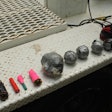On the night of Aug. 5, 2009, Brenda Arenas' mother took her shopping. The 15-year-old girl was jazzed about looking for a dress for her quinceañera, a Latino coming-of-age ritual marking the transition to womanhood.
The sophomore from Sunnyside High in Tucson, Ariz., found her dress and was heading home. Her mother needed to make a stop on the way. So the family sedan that carried Brenda, her 3-year-old sister in the rear seat, and her mother pulled into the parking lot of a Circle K convenience store.
Moments earlier a few blocks to the west, six armed men exited a house they had mistakenly broken into in an attempt to steal a rival crew's drug load.
Three of those men — later identified as Christian Betza Vasquez, 24; Orel S. Vasquez, 19; and Juan Carlos Leon, 27 — ran east toward the Circle K, following the botched home invasion.
The men attempted to carjack the Arenas' sedan. But Brenda's mother refused to stop the vehicle even when the men pointed their pistols at her. One of the men then fired a round that punched through the front windshield, striking the 15-year-old in the head and leaving her in critical condition.
Brenda's mom raced inside the store and pleaded with the clerk to call 911 as the suspects fled in a grey SUV, possibly a Dodge Durango. Rescue personnel transported the girl to the University Medical Center, where she was pronounced dead at 8:50 p.m.
"Instead of her using her dress to attend her quinceañera, she was buried in it," says Sgt. Bob Jimenez of the Tucson Police Department. "It was a very sad story that affected a lot of people here in Tucson."
Jimenez now heads the Tucson PD's home-invasion unit, which was formed in part due to the community's outrage following Brenda's tragic death. Unfortunately, there has been no justice for Brenda Arenas. Three warrants were issued, but the suspects have never been caught. Jimenez thinks they fled to Mexico immediately after the crime.
A Growing Problem
Teenage girls like Brenda Arenas are not the typical victims of home invasion robberies; she was an innocent caught in the wrong place at the wrong time. Most home invasion victims are not so innocent.
The Tucson PD reported 150 home invasions in 2008 and another 115 in 2009, the year Brenda Arenas was killed. Statistics for the rest of the nation are hard to come by. The crime isn't tracked by many law enforcement agencies or nationally by the FBI, which lumps them in with burglaries or assaults. But one thing is sure, law enforcement officials say the incidence of home invasion robbery is on the rise nationwide, in large part due to the activities of Mexican drug cartels.
The incidence of home invasions may even be higher than law enforcement officials think. Home invasions often go unreported because the mid- or higher-level dealer "victim" won't report the crime to police. Single ransoms have exceeded $1 million in Phoenix, where exchanges are often arranged without the involvement of law enforcement.
Drug-related home invasions are especially prevalent in the Sunbelt. Southern Arizona, Texas, and Atlanta serve as distribution points for traffickers delivering narcotic loads from Mexican drug trafficking organizations to distribution points where dealers and street gangs wait for their arrival.
Law enforcement experts say that home invasions are often the way that the DTOs force associates to pay their debts. Cartel associates who fail to deliver narcotic loads — even if the drugs fall into the hands of law enforcement — can pay a heavy price. Their employers enforce discipline by kidnapping, torture, and murder and fines for poor performance are often exacted by extortion.
Going in Hot
Home invasions are "hot" burglaries that can be classified into several categories, including armed burglaries, meth addicts looking for dope, street robbers looking for targets of opportunity, drug deals gone bad, illegal aliens working off drug debt, and ransom kidnappings.[PAGEBREAK]
When a home invasion is a cartel operation, it can be as elaborately staged and planned as a military raid. Tactical entry crews are given military training, possess military-grade weapons, and use SWAT-like small unit tactics. They are often skilled at counter-surveillance and can pose as police units. They have even been known to wear jackets with "POLICE" on the back, drive vehicles painted in black-and-white color schemes, and yell "Police, open up!" or a variant of that phrase, hoping to scare their victims into submissive compliance.
Drug Rips
The tactical cartel crews are very dangerous for both civilians and law enforcement, but a bigger worry is the unprofessional crew that's just looking to make a quick drug rip.
Drug rip home invasions usually occur late at night or at dawn with residents inside the house, and the invaders expect armed resistance. Invaders looking to heist drugs or cash travel in packs to appear overwhelming to subjects they expect will resist.
In one Tucson case, rival crews exchanged a barrage of gunfire in a hallway with a resident who unloaded his AK-47 from an ensconced position inside his bedroom. High-powered rounds ricocheted through the interior door and sheetrock. When police arrived, the house was empty.
In another case, officers surrounded a house occupied by two recently furloughed Marines with AK-47s, a modified-stock 12-gauge shotgun, and semi-auto pistols with high-capacity double-stack magazines. One Marine had reportedly double-crossed the other by bringing in a third crew to heist the specially grown "hydro weed."
Blood Money
The unprofessional drug rip is the most common home invasion robbery nationwide, but near the border cartel operations keep law enforcement on edge.
Because of recent success by the Mexican government in disrupting cartel operations, agents with the Drug Enforcement Administration say they're seeing a tightening of the cocaine market.
Cartels are less willing to extend credit to transporters and payment deadlines are often moved up, putting added pressure on transporters. "There is a shorter window on payment," says Rodney Benson, the DEA's special agent in charge of the Atlanta field division. "So when somebody doesn't pay on time, we see drug-related kidnappings here."
Benson heads a multi-agency task force that includes 10 local deputies and officers who have been deputized by the DEA to enforce the Controlled Substances Act (Title 21 in the Code of Federal Regulations). The agents use the same workspace to operate enforcement missions in Georgia, North Carolina, and Tennessee.
"I look at violence and drug trafficking going hand in hand," Benson says.
In July 2008, Gulf cartel associates lured Oscar Reynoso, 31, to the Atlanta area from Rhode Island under the ruse of completing a vehicle purchase. Reynoso had allegedly lost a $300,000 load to law enforcement. And the cartel wanted its money.
Reynoso was taken to a house in a middle-class neighborhood in the Atlanta suburb of Lilburn. When he entered the garage supposedly to inspect the vehicle, he was jumped by eight people, beaten, and blindfolded. He was then dragged into the house's basement and chained to a mattress. With duct tape covering his eyes, Reynoso was forced to drink his own urine. He was rescued by officers of the Gwinnett County Police Department and Fayette County Sheriff's Department who raided the home and arrested three Mexican nationals.[PAGEBREAK]
Missing Persons
In some ways, Oscar Reynoso was lucky. He stayed in the U.S., and he survived his ordeal.
The same can't be said for Sergio Saucedo. He was taken from his El Paso-area home on Sept. 3, 2009, by two Mexican nationals and a third man. The kidnapping was retaliation for a seizure by Border Patrol agents of 670 pounds of marijuana from a tractor-trailer at a checkpoint in Sierra Blanca a month earlier.
Saucedo, who had a long criminal record, was bound with duct tape in his Horizon City home as his wife looked on. He was taken out the back door to a driveway, where he was stuffed into a dark SUV with no license plates and driven across the border.
It would be his last trip to Ciudad Juarez.
Saucedo's body was found several days later dumped in the street with his severed arms placed on top of a cardboard sign on his chest. The killers stuffed plastic bags into Saucedo's mouth and taped his eyes.
Home invasions and kidnappings also plague Phoenix. In 2008, the most recent year for which complete statistics are available, there were 368 reported kidnappings in Phoenix, up from 160 in 1999. More than 90 percent are drug-related.
To combat the rising crime, the Phoenix PD created its Home Invasion Kidnapping Enforcement Unit (HIKE) last year. Prior to that, home invasions were investigated by the robbery unit within the violent crimes bureau.
"The kidnappings and home invasions are by organized crews, and they seem to mimic tactics that are being used in Mexico," says Lt. Lauri Burgett, who oversees the HIKE unit. "I definitely see a growth in home invasions."
Victims are reluctant to come forward. And perpetrators armed with enough information about their subject can extort upwards of $1 million, depending on the importance of the victim in the trafficking hierarchy.
"They're after product or they're after money," Burgett adds. "They hold them and force the family to come forward with those things."
And if people don't pay they may be disappeared by the cartel. Last October, Phoenix police responded to a home after a 32-year-old Latino man ran onto a nearby school yard with duct tape still attached to his body and told the children that some men had threatened to kill him.
Investigators discovered that the man had lost a $500,000 narcotic load. When he didn't arrange payment, the cartel responded with a home invasion.
His attackers brought heavy equipment to the man's house and, as he sat bound to a chair, began cutting the foundation of the converted garage to dig his grave. Police arrived to find a hole six feet across and five feet deep with a smaller hole at the bottom just wide enough for feet. Fresh concrete had been poured into the hole.
Burgett says this case shows how ruthless, methodical, and prepared cartel home invasion crews can be. She advises patrol units responding to home invasions to take extra precautions. These include setting up a wider perimeter, and approaching the home as you would any other high-risk encounter that may result in a gunfight.
"Approach the scene with the knowledge that somebody probably has surveillance and firepower that's pretty good," Burgett recommends.



















